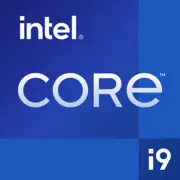Intel Core i9-11900T

Intel Core i9-11900T: Review and Analysis of the Processor for Compact Systems (2025)
Introduction
The Intel Core i9-11900T processor, released in 2021, remains a relevant solution for niche tasks even in 2025. Despite its age, its unique combination of low power consumption and high performance makes it an appealing choice for specific scenarios. Let's explore who might benefit from this chip today.
Key Specifications: Architecture and Key Features
Architecture and Process Technology
The i9-11900T is based on the Rocket Lake-S architecture (14 nm), which was the last for Intel before transitioning to 10 nm (Alder Lake). Despite the "older" process technology, the chip has received a number of improvements:
- Support for PCIe 4.0 (20 lanes).
- Improved IPC (Instructions Per Cycle) by 19% compared to Comet Lake.
- Intel UHD Graphics 750 — integrated graphics with a base frequency of 350 MHz.
Performance
- 8 cores / 16 threads with flexible frequency management:
- Base frequency: 1.5 GHz (to reduce TDP).
- Turbo Boost up to 4.9 GHz (single core).
- Geekbench 6:
- Single-core: 2198 (comparable to Ryzen 5 7600X).
- Multi-threaded: 9505 (close to Ryzen 7 5700X).
Key Features
- Adaptix Boost — frequency optimization under load.
- Support for Resizable BAR for gaming.
- Thermal Velocity Boost — automatic overclocking at low temperatures.
Compatible Motherboards: Sockets and Chipsets
The processor uses the LGA 1200 socket, limiting the choice to 500 series boards:
- Z590: For enthusiasts (overclocking, PCIe 4.0 x8/x8). Example: ASUS ROG Strix Z590-E (from $250 in 2025).
- B560: The best choice for most users (supports DDR4-3200 memory, PCIe 4.0 x4). Example: MSI B560M PRO-VDH (from $120).
- H510: Budget option (no PCIe 4.0). Suitable for office PCs.
Choosing Features
- To activate PCIe 4.0, a board with the Z590/B560 chipset and a compatible M.2 slot is required.
- Low TDP (35 W) allows for the use of compact Mini-ITX boards, such as the ASRock H510M-ITX/ac.
Supported Memory Types
The i9-11900T only works with DDR4:
- Officially: DDR4-3200 (in dual-channel mode).
- Maximum capacity: 128 GB (4 slots).
Recommendations
- Optimal option: 2x16 GB DDR4-3200 CL16 (for example, Crucial Ballistix, $80–100).
- For gaming: DDR4-3600 (with overclocking via XMP).
Power Supplies: Power Calculation
With a TDP of 35 W, the processor rarely consumes more than 70 W at peak. However, the choice of power supply depends on the other components:
- Integrated graphics: 300–400 W is sufficient (for example, be quiet! Pure Power 11 400W, $60).
- With a discrete graphics card:
- For RTX 4060: 500–550 W (Corsair CX550M, $70).
- For RTX 4070: 650 W (Seasonic FOCUS GX-650, $110).
Tip: In compact builds, look for SFX format power supplies (for example, Cooler Master V650 SFX, $120).
Pros and Cons
Pros:
- Energy efficiency: Ideal for mini-PCs and passive cooling systems.
- Strong single-core performance: Suitable for gaming and IPC-dependent tasks.
- PCIe 4.0 support: Relevant for fast NVMe drives.
Cons:
- Outdated process technology: Lags in multi-threading compared to Ryzen 5000/7000.
- No DDR5 and PCIe 5.0: Not suitable for future upgrades.
- Limited overclocking headroom: Turbo modes depend on temperature.
Use Cases
1. Compact PCs and HTPCs: Low heat output allows for the construction of quiet systems for 4K video (for example, in a Fractal Design Node 202 case).
2. Office Workstations: Fast data processing in Excel, Photoshop.
3. 1080p/1440p Gaming: Paired with RTX 4060, provides 60+ FPS in AAA titles (Cyberpunk 2077, Starfield).
4. Entry-Level Servers: Virtualization and query processing thanks to 16 threads.
Practical Example: A user built a PC with the i9-11900T and RTX 3060 in a Silverstone ML08 case for 1440p gaming. Result: stable 60 FPS in Horizon Zero Dawn with system power consumption under 200 W.
Comparison with Competitors
In 2025, the main competitors are:
- AMD Ryzen 7 5700X (8C/16T, 65 W, $180):
- Pros: Higher multi-threaded performance (+15% in Cinebench R23).
- Cons: No PCIe 4.0 on budget chipsets (A520).
- Intel Core i5-13400T (10C/16T, 35 W, $220):
- Pros: Newer cores (Raptor Lake), DDR5 support.
- Cons: Higher price.
Conclusion: The i9-11900T excels in systems where the balance of price and power consumption is critical.
Practical Assembly Tips
1. Cooling: Even with a TDP of 35 W, use a cooler with headroom (e.g., Noctua NH-L9i).
2. Storage: Choose NVMe SSDs with PCIe 4.0 (Samsung 980 PRO) for maximum speed.
3. Case: For mini-PCs, opt for models with top ventilation (Cooler Master NR200).
4. Upgrade: If you already have an LGA 1200 board, the i9-11900T is an excellent choice. For new builds, consider Alder Lake/Raptor Lake.
Final Conclusion: Who Should Consider the i9-11900T in 2025?
This processor is worth choosing if:
- You need an energy-efficient PC for office use, a media center, or a compact gaming system.
- You require an upgrade for an old LGA 1200 platform without replacing the motherboard.
- A low noise level and minimal heat output are important.
Price in 2025: $200–220 (new). With a limited budget and specific requirements, the i9-11900T remains a cost-effective solution despite its age. However, for new projects starting from scratch, it is advisable to look at chips with DDR5 and PCIe 5.0.
Basic
CPU Specifications
Memory Specifications
GPU Specifications
Benchmarks
Compared to Other CPU
Share in social media
Or Link To Us
<a href="https://cputronic.com/en/cpu/intel-core-i9-11900t" target="_blank">Intel Core i9-11900T</a>